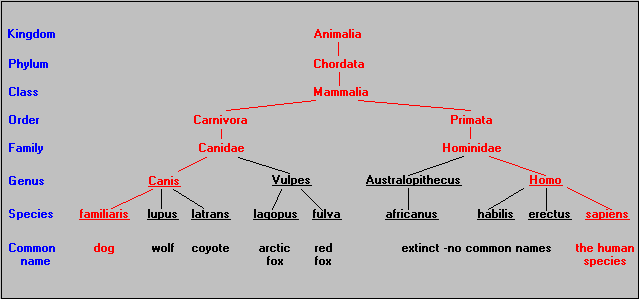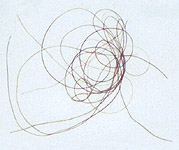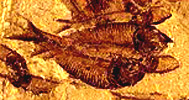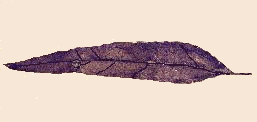| EON |
ERA |
PERIOD |
Based on the great changes in the record of life, the
Earth's history has been subdivided into four major intervals of time,
eons,
characterized principally by the life forms that existed at that time.
These eons have been further subdivided into smaller units, eras, periods
and epochs. This calendar for the earth is referred to as the Geologic
Time Scale, and it is this time scale to which geologists usally
refer when discussing its history. Remember that although such a scale
(like this one) is often labeled with absolute dates, it is based
on fossils. Fossils are powerful tools; and in many ways they are
the only reliable ones available to a geologist when it comes to unravelling
the history of the earth. Still, while we may be able to ascribe an extremely
accurate relative age to a fossil,
a layer or an event, we cannot know how many thousands or millions of years
ago that event took place. Such determinations, called absolute dates,
are done by using techniques which involve physical or chemical changes
which occur at known rates. The most powerful of these techniques of absolute
dating are radiometric that use the decay of radioactive atoms to measure
time. |
Phanerozoic
700 MY-PRESENT |
Cenozoic
66MY-Present
|
Quaternary 1.8 MY-Now
Tertiary 66-1.8
MY |
Mesozoic
248-66 MY |
Cretaceous 144-66
MY
Jurassic 202-144
MY
Triassic 248-202
MY |
Paleozoic
700-248MY |
Permian 286-248
MY
Pennsylvanian 320-286 MY
Mississipian 360-320 MY
Devonian 408-360
MY
Silurian 438-408
MY
Ordovician 505-438 MY
Cambrian 544-505
MY
|
Proterozoic
2.5-0.7 BY |
Late 1.3-0.7
BY |
Vendian**
700-544 MY
No Periods older than the Vendian |
| Middle 1.6-1.3
BY |
|
| Early 2.5-1.6
BY |
|
Archean
3.9-2.5 BY |
Late 3.0-2.5BY |
|
| Middle 3.4-3.0 BY |
|
| Early 3.9-3.4
BY |
Hadean
>3.9 BY |
No Hadean Eras >3.9BY |
|
**NOTE:
Although the Vendian (=Ediacaran) is usually considered a period of the
Late Proterozoic Era, some authorities consider it the oldest period of
the Paleozoic.
Fosssils have thrilled, excited fascinated and challenged countless
people. Their aesthetic beauty alone has assured them a place in our homes
and hearts. Everyone who has ever seen the skeleton of one of the large
dinosaurs has stopped in awe. The mere existence of fossils has sparked
controversy; and understanding how they formed, lived and their relationship
to other fossils has given us a clearer glimpse of the past. Without them
we would have but a fraction of the knowledge we posess about the earth.
CLASSIFICATION OF FOSSILS
Living things and the world they inhabit are the product of four billion
years of evolution. Life is an organic whole whose components are all
related to a greater or lesser degree. In order to express this inter-relationship,
we use the same classification for fossils as for living organisms. This
classification system (=taxonomy) was devised in the latter part
of the XVIIIth Cent. by Carl von Linne, a Swede whose great invention
was twofold: first, binomial nomenclature (the naming of each species
with two unique names, often called the scientific name). Secondly, the
Linnean classification scheme indicates the relationships between all
species that were and are alive, and allows us to sort organisms into
appropriate categories based on the degree of relationship rather than
by differences. Linne had no concept of genetics in the modern sense, but
his classification method foreshadowed this century's discoveries that
leave no doubt that all organisms are genetically related.
Why bother with complicated foreign scientific names?
We use binomial nomenclature, (or scientific names) rather than common
(every day) names because common names lead to confusion. Suppose we want
to talk to someone about a salamander. Most people know what that is, or
at least they think so. Unfortunately that is often not the case. For example,
in most of the english-speaking world a salamander is an amphibian, related
to newts and frogs. In the rural SE US, a salamander is a rodent (related
to rats) that burrows and makes mounds in sandy soil. (In fact salamander
is a corruption of "sandy mounder"). In other parts of the US this rodent
is known as a pocket gopher. In the South and West, though, a gopher is
a tortoise (land turtle). Such confusing examples are all too common.
Also, when people interact commonly with another species they tend to
use lots of names for that same species; think of the variety of names
applied to horses or dogs. If they do not, they tend to lump species that
have a similar appearance under the same name. " What kind of tree is this?
That's an oak...". So all of these common names interfere with our
ability to communicate. What makes binomial nomenclature so useful
is that each species has a unique pair of names and that removes
any ambiguity. Also, there are no common names for fossil species or for
those that disappeared before man began to record his descriptions of the
world. Thus taxonomy allows clarity in communication.
Taxonomy also clarifies relationships.
It is generally accepted that life originated but once on this planet.
Because all organisms arose from this original life, they are all related
and that means we can put them into taxa (=groupings) which express
their degree of relationship. These groupings or categories are hierarchical,
meaning that they are arranged in a series of ever larger, broader groupings.
The only real grouping is the species,commonly defined as a group
of organisms that interbreed naturally and produce fertile offspring. All
other categories (=taxa, the plural of taxon) express only our knowledge
as to the degree of relationship between species, and therefore, as our
knowledge changes, so does taxonomy.
This functional definition of a species creates a special problem for
the paleontologist, because we can't tell how fossil organisms reproduced.
We assume that if a group of organisms is genetically different enough
to be a species, these differences will be large enough to affect the physical
appearance of the organisms, and these differences will show up in the
preserved parts. Although this makes identification and classification
of fossil species occasionally difficult, it works well enough in practice
to sort out the lines of evolutionary relationships and to put together
a classification scheme valid for both modern and fossil species.
Linnean classification
In the Linnean classification, the fundamental taxon is the species.
Closely related species make up a genus. Related genera in turn
make up a family. Families make up orders and orders, a class;
classes make up a phylum and phyla in turn, a kingdom the
highest level of classification commonly used in taxonomy.
Each of these taxa (levels) can be further refined by using such prefixes
as sub- or super-, and detailed classification schemes may
use other specialized terms such as tribe and cohort. In the main the basic
system outlined above will serve our purposes well enough.

A diagrammatic representation of the classification of two species:
A man and his dog.
As stated before, the fundamental unit of classification is the species.
Every species is identified by a unique combination of two names (binomial
nomenclature): the generic (genus) and specific (species) name. The generic
names comes first and is always capitalized, while the specific name is
always lower case. Both names must always be underlined or italicized.
for example, the scientific name for a dog is Canis familiaris or
Canis
familiaris.
|



 Not
all evidence includes the actual remains. Indirect
evidence includes molds, casts, imprints, coprolites and tracks.
Molds
are the hollows left in the surrounding material (the matrix) after the
remains of the organism have been dissolved or removed. Some of the most
famous historical molds were discovered in Pompei where the remains of
fleeing Romans were entombed in the vulcanic ash of the 79AD eruption of
Mt. Vesuvius. Archeologists were able to fill these molds with plaster
and these casts provide us with a glimpse of the people as they
fell and died
Not
all evidence includes the actual remains. Indirect
evidence includes molds, casts, imprints, coprolites and tracks.
Molds
are the hollows left in the surrounding material (the matrix) after the
remains of the organism have been dissolved or removed. Some of the most
famous historical molds were discovered in Pompei where the remains of
fleeing Romans were entombed in the vulcanic ash of the 79AD eruption of
Mt. Vesuvius. Archeologists were able to fill these molds with plaster
and these casts provide us with a glimpse of the people as they
fell and died  from
suffocation. This process occurs when a different mineral fills in molds
and preserves a replica of the original. Leaves and other fossils often
leave their imprints on rocks and, in a way, tracks are nothing
but a special kind of imprint. In some cases we only know that an organism
existed because we have found its tracks. Finally
coprolites,
(fossilized feces) have given us much information about the digestive systems
and dietary habits of many an extinct animal, as well as for early man.
from
suffocation. This process occurs when a different mineral fills in molds
and preserves a replica of the original. Leaves and other fossils often
leave their imprints on rocks and, in a way, tracks are nothing
but a special kind of imprint. In some cases we only know that an organism
existed because we have found its tracks. Finally
coprolites,
(fossilized feces) have given us much information about the digestive systems
and dietary habits of many an extinct animal, as well as for early man.